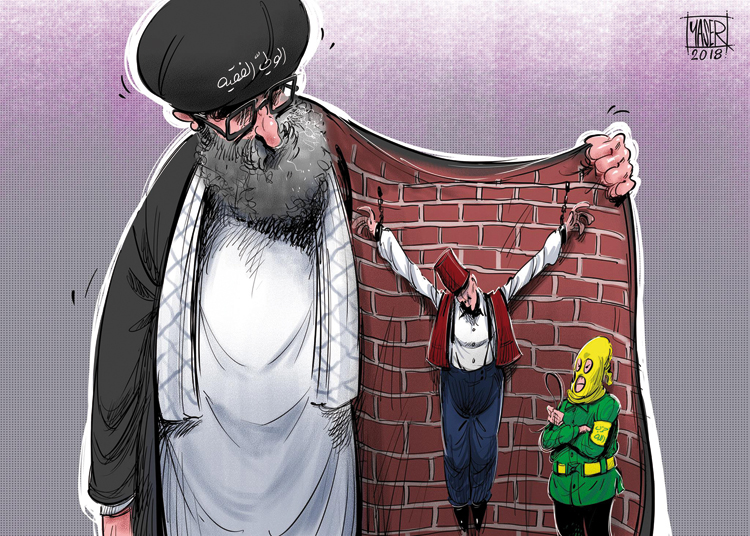Iranian regime is getting richer, at the expense of the poor
النظام الإيراني يزداد ثراءً على حساب الفقراء من الشعب الإيراني
Dr. Majid Rafizadeh/Arab News/August 09/18
The latest large-scale protests in several Iranian cities have created a significant challenge to Iran’s ruling political establishment. The protests are not isolated events but a continuation of the widespread anti-government movement that began in late 2017. The most recent protests broke out not only in small towns and cities, but also in the major hubs of Tehran, Isfahan, Karaj, Shiraz, Rasht, Khuzestan and Tabriz.
One of the key grievances of the demonstrators is economic inequality and financial hardship. Many protesters have been taking to the streets to express their frustration, anger and outrage over the ongoing financial crisis, which is caused by the high unemployment rate, skyrocketing inflation, and the rapid devaluation of the currency.
But why would a wealthy country like Iran be afflicted with such economic misery? It is worth noting that Iran is one of the richest countries in the world when it comes to natural resources and commodities. In fact, by having approximately $27.3 trillion in natural resources, Iran is ranked fifth in the world, ahead of China and Australia and only behind Canada, the US, Saudi Arabia and Russia.
The nation has the world’s second and fourth largest gas and oil reserves respectively. Iran has roughly one-sixth of the world’s gas reserves with a value of nearly $12 trillion, and one-tenth of the world’s oil reserves worth almost $17 trillion. Iran is the 18th largest country in the world when it comes to purchasing power parity. In addition, the country is considered the largest car manufacturer in the Middle East.
It is worth noting that Iran is one of the richest countries in the world when it comes to natural resources and commodities
In fact, enriched with a plentitude of natural resources and commodities, Iran has the potential to become one of the 11 largest economies in the world, according to Goldman Sachs investment banker and economist Jim O’Neill. Even the Iranian leaders, including President Hassan Rouhani, have acknowledged this fact.
When Rouhani came to power, he promised to improve the economy and people’s living standards. Instead, the economic situation has deteriorated exponentially. Rouhani is not the first mullah to make such failed economic promises. In fact, in order to gain and maintain power, the regime itself is based on the concept of making deceitful economic promises to its citizens.
For example, when the ruling mullahs sought to grasp more power in 1979, they made several promises to the nation. When the founder of the Islamic Republic, Ayatollah Ruhollah Khomeini returned to Tehran from Paris, he famously promised to bring “oil to the people’s tables,” meaning that the money from the nation’s oil exports would be distributed among the people. He also pledged that no one would have to pay for water and electricity in the country. The tape of Khomeini’s famous speech was banned after he assumed power.
This brings us to the million dollar question: Where is the nation’s wealth? The country is plagued with a stark rich-poor divide. There exists no robust socio-economic class, which can be identified as the middle class.
While the ruling politicians, those who are connected with them, and the regime’s loyalists are getting richer, the ordinary people are becoming poorer. For example, Iran’s Supreme Leader Ali Khamenei, who is the second longest-ruling autocrat in the Middle East, gained most of his wealth after 1979. His financial empire is currently proven to be worth at least $95 billion; not only does this make him the richest autocrat Iran has ever had, but most likely the richest man in the world. Leaked reports have also revealed that Khamenei, his son Mojtaba and other family members allegedly keep billions of dollars in foreign banks.
Through nepotism, corruption, connections and illicit financial activities such as insider trading and disruption of the market, some officials and their families and friends have accumulated significant wealth, while millions of ordinary people cannot make ends meet. In fact, after the Iranian regime was granted significant sanctions relief and benefited from a rise in oil exports thanks to the Joint Comprehensive Plan of Action, not only did the Iranian people not experience the fruits of the sanctions’ relief, but their economic situation has become much more severe since 2015. Roughly 35 million Iranians (nearly 40 percent of the population) are currently living under the poverty line.
The stark rich-poor divide in Iran is the direct result of the accumulation of wealth by Iranian leaders and those who are connected to them, at the expense of the poor. Political authoritarianism may survive longer if there is at least economic liberalizations and equality. But political authoritarianism without redistribution of wealth and economic opportunities for the ordinary people is suicidal for the ruling power.
**Dr. Majid Rafizadeh is a Harvard-educated Iranian-American political scientist. He is a leading expert on Iran and US foreign policy, a businessman and president of the International American Council. Twitter: @Dr_Rafizadeh






















